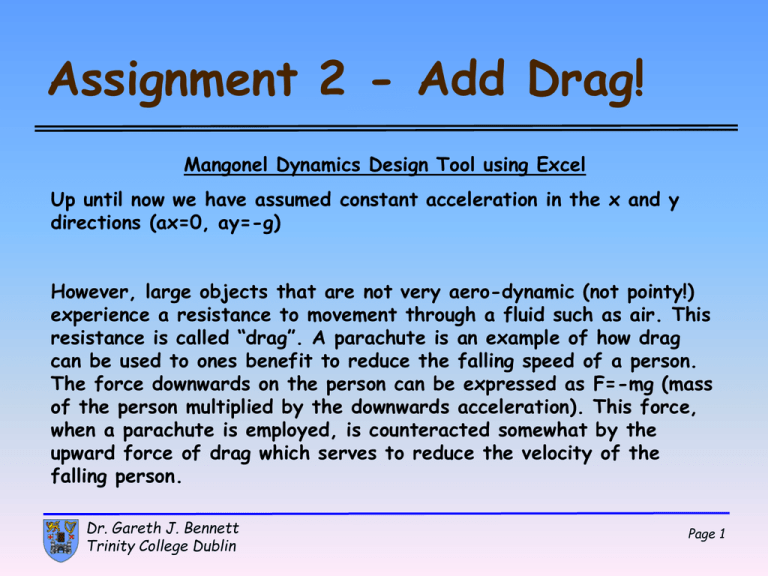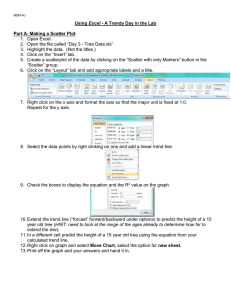Dynamics_1E10_GB_2_prot
advertisement

Assignment 2 - Add Drag! Mangonel Dynamics Design Tool using Excel Up until now we have assumed constant acceleration in the x and y directions (ax=0, ay=-g) However, large objects that are not very aero-dynamic (not pointy!) experience a resistance to movement through a fluid such as air. This resistance is called “drag”. A parachute is an example of how drag can be used to ones benefit to reduce the falling speed of a person. The force downwards on the person can be expressed as F=-mg (mass of the person multiplied by the downwards acceleration). This force, when a parachute is employed, is counteracted somewhat by the upward force of drag which serves to reduce the velocity of the falling person. Dr. Gareth J. Bennett Trinity College Dublin Page 1 Assignment 2 - Add Drag! The “missile” which our Mangonel will fire will be something like a squash-ball which is spherical See fig 1. a. b. Fig 1. Prototype of our Mangonel! Dr. Gareth J. Bennett Trinity College Dublin Page 2 Assignment 2 - Add Drag! This squash ball will experience drag as it is projected through the air. The questions you need to ask yourselves are; What are the factors that control drag and how can you reduce it? If you can reduce drag then your missile will travel further! Dr. Gareth J. Bennett Trinity College Dublin Page 3 Assignment 2 - Add Drag! You may be familiar to images such as that shown in fig 2 (a). “Flow visualisation” allows a streamline around a body such as a car to be determined. Fig 2 (b) shows how cars have become more aero-dynamic and hence more fuel efficient over time. a. b. Fig 2. Car aero-dynamics Dr. Gareth J. Bennett Trinity College Dublin Page 4 Assignment 2 - Add Drag! The equation that expresses the drag force (Fd) is: Fd=1/2 ρ A V2 Cd ρ =Density of air A =Projected area of the body V =Velocity of the body Cd =Drag Coefficient Dr. Gareth J. Bennett Trinity College Dublin Page 5 Assignment 2 - Add Drag! So, we see the drag force increases with size and velocity. It makes sense to reduce the size but what about the velocity? Fd=1/2 ρ A V2 Cd If we reduce the velocity the drag force reduces but the missile wont go as far! Dr. Gareth J. Bennett Trinity College Dublin Page 6 Assignment 2 - Add Drag! Cd: The Drag Coefficient Typically, the approach in such situations is, for a fixed velocity, to reduce the drag coefficient, where the drag coefficient is the parameter which characterises how aero-dynamic the body is. Fd=1/2 ρ A V2 Cd In fig. 2b, we see that it is Cd that is plotted on the y-axis. Dr. Gareth J. Bennett Trinity College Dublin Page 7 Assignment 2 - Add Drag! What causes drag? The drag force is due to pressure losses caused by recirculation of flow. Simply put; eddies and vortices which are caused by abrupt changes in geometry. In figure 3, although much smaller, the cylinder experiences the same drag force as the much larger but more aero-dynamic airfoil. This is due to the relatively greater amount of “turbulence” in the wake. Fig 3. Dr. Gareth J. Bennett Trinity College Dublin Page 8 Assignment 2 - Add Drag! Acceleration due to drag For our assignment, in order to calculate the new trajectory, we need to calculate the acceleration due to drag. By performing a mass balance (Newton’s 2nd Law), we can write Fd=1/2 ρ A Dr. Gareth J. Bennett Trinity College Dublin V2 Cd=mad m= mass of the body ad=acceleration due to drag Page 9 Assignment 2 - Add Drag! Acceleration due to drag: From this we have ad= 1/(2m) Cd ρ A V2 The magnitude of the acceleration is thus expressed ad = 1/(2m) Cd ρ A (vx2+vy2) Constant (k) Dr. Gareth J. Bennett Trinity College Dublin Page 10 Assignment 2 - Add Drag! Acceleration due to drag: Thus; ayd = k (vx2+vy2) Sin(ß) axd = k (vx2+vy2) Cos(ß) Therefore; ax=0-k (vx2+vy2) Cos(ß) and ay=-9.81-k (vx2+vy2) Sin(ß) where ß=tan-1(vy/vx) Dr. Gareth J. Bennett Trinity College Dublin Page 11 Assignment 2 - Add Drag! Acceleration due to drag: We see now that the acceleration depends on the changing velocity and so is no longer a constant but depends on the velocity at each step!!!! Don’t confuse the angle ß which changes at each step depending on the velocity vectors, with the initial launch angle θ which remains fixed once chosen. Try and implement the equations in yellow into the spreadsheet to see the effect of drag! Dr. Gareth J. Bennett Trinity College Dublin Page 12 Assignment 2 - Add Drag! Input Data Position Change to see 15.00 impact!!!! 0.01 Change to see 60.00 impact!!!! 1.05 Vel delt t theta (degrees) theta (radians) Drag Data rho 1.20 Cd 0.40 m 0.050 D Area Constant, K 0.045 0.0016 0.01 The value at atmospheric conditions This is a typical value, however try and change it! Change to see impact!!!! Change to see impact!!!! t x y vx vy 1.00 0.00 0.00 0.00 7.51 12.99 2.00 0.01 0.08 0.13 7.50 12.87 beta [rads] cos(beta) sin(beta) ax ay 1.04667 1.04337 0.50046 0.50331 0.86576 0.86411 -0.85919 -0.85237 -11.29633 -11.27338 12.76 12.65 12.54 12.42 12.31 12.20 12.09 11.98 1.04003 1.03666 1.03323 1.02977 1.02626 1.02270 1.01910 1.01545 0.50619 0.50910 0.51204 0.51502 0.51802 0.52106 0.52413 0.52723 0.86242 0.86071 0.85896 0.85718 0.85537 0.85352 0.85164 0.84972 -0.84559 -0.83886 -0.83217 -0.82552 -0.81892 -0.81236 -0.80584 -0.79936 -11.25067 -11.22820 -11.20597 -11.18397 -11.16220 -11.14067 -11.11937 -11.09829 11.00 0.10 0.75 1.24 7.42 11.87 1.01176 0.53037 0.84777 -0.79292 -11.07744 12.00 0.11 0.82 1.36 7.42 11.76 1.00802 0.53354 0.84577 -0.78653 -11.05682 13.00 0.12 0.89 1.48 7.41 11.65 1.00422 0.53674 0.84375 -0.78018 -11.03642 14.00 0.13 0.97 1.59 7.40 11.54 15.00 0.14 1.04 1.71 7.39 11.42 16.00 0.15 1.12 1.82 7.38 11.31 1.00038 0.99649 0.99254 0.53998 0.54325 0.54656 0.84168 0.83957 0.83742 -0.77387 -0.76760 -0.76137 -11.01624 -10.99628 -10.97654 3.00 4.00 5.00 6.00 7.00 8.00 9.00 10.00 0.02 0.03 0.04 0.05 0.06 0.07 0.08 0.09 0.15 0.22 0.30 0.37 0.45 0.52 0.60 0.67 0.26 0.38 0.51 0.64 0.76 0.88 1.00 1.12 7.49 7.48 7.47 7.46 7.46 7.45 7.44 7.43 Calculate ß, for each step, depending on the velocity Dr. Gareth J. Bennett Trinity College Dublin Page 13 Assignment 2 - Add Drag! Input Data Position Change to see 15.00 impact!!!! 0.01 Change to see 60.00 impact!!!! 1.05 Vel delt t theta (degrees) theta (radians) Drag Data rho 1.20 Cd 0.40 m 0.050 D Area Constant, K 0.045 0.0016 0.01 The value at atmospheric conditions This is a typical value, however try and change it! Change to see impact!!!! Change to see impact!!!! t x y vx vy 1.00 0.00 0.00 0.00 7.51 12.99 2.00 0.01 0.08 0.13 7.50 12.87 beta [rads] cos(beta) sin(beta) ax ay 1.04667 1.04337 0.50046 0.50331 0.86576 0.86411 -0.85919 -0.85237 -11.29633 -11.27338 12.76 12.65 12.54 12.42 12.31 12.20 12.09 11.98 1.04003 1.03666 1.03323 1.02977 1.02626 1.02270 1.01910 1.01545 0.50619 0.50910 0.51204 0.51502 0.51802 0.52106 0.52413 0.52723 0.86242 0.86071 0.85896 0.85718 0.85537 0.85352 0.85164 0.84972 -0.84559 -0.83886 -0.83217 -0.82552 -0.81892 -0.81236 -0.80584 -0.79936 -11.25067 -11.22820 -11.20597 -11.18397 -11.16220 -11.14067 -11.11937 -11.09829 11.00 0.10 0.75 1.24 7.42 11.87 1.01176 0.53037 0.84777 -0.79292 -11.07744 12.00 0.11 0.82 1.36 7.42 11.76 1.00802 0.53354 0.84577 -0.78653 -11.05682 13.00 0.12 0.89 1.48 7.41 11.65 1.00422 0.53674 0.84375 -0.78018 -11.03642 14.00 0.13 0.97 1.59 7.40 11.54 15.00 0.14 1.04 1.71 7.39 11.42 16.00 0.15 1.12 1.82 7.38 11.31 1.00038 0.99649 0.99254 0.53998 0.54325 0.54656 0.84168 0.83957 0.83742 -0.77387 -0.76760 -0.76137 -11.01624 -10.99628 -10.97654 3.00 4.00 5.00 6.00 7.00 8.00 9.00 10.00 0.02 0.03 0.04 0.05 0.06 0.07 0.08 0.09 0.15 0.22 0.30 0.37 0.45 0.52 0.60 0.67 0.26 0.38 0.51 0.64 0.76 0.88 1.00 1.12 7.49 7.48 7.47 7.46 7.46 7.45 7.44 7.43 Modify the accelerations for each step depending on ß and on the velocities Dr. Gareth J. Bennett Trinity College Dublin Page 14 Assignment 2 - Add Drag! Try and superimpose the “no drag” and “with drag” plots! Two sheets! Dr. Gareth J. Bennett Trinity College Dublin Page 15 Assignment 2 - Add Drag! Adjust Cd, mass and the diameter the see effect as well as the initial velocity and launch angle! Dr. Gareth J. Bennett Trinity College Dublin Page 16 Assignment 2 - Add Drag! One more thing! When you square velocity, the result will be always positive. However, if the drag is always going to be acting against the direction of velocity we need to be aware of the “sign” of the velocity. How can we keep that information in the Excel spread sheet equations? Good luck! Dr. Gareth J. Bennett Trinity College Dublin Page 17






